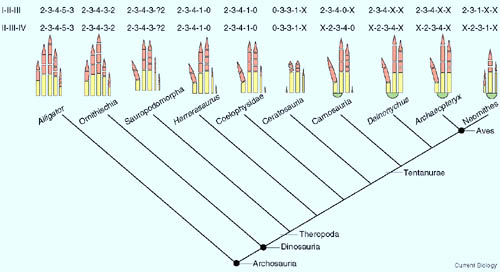Tracing the Evolution of Avian Wing Digits
It is widely accepted that birds are a subgroup of dinosaurs, but there is an apparent conflict: modern birds have been thought to possess only the middle three fingers (digits II-III-IV) of an idealized five-digit tetrapod hand based on embryological data, but their Mesozoic tetanuran dinosaur ancestors are considered to have the first three digits (I-II-III) based on fossil evidence. How could such an evolutionary quirk arise? Various hypotheses have been proposed to resolve this paradox. Adding to the confusion, some recent developmental studies support a I-II-III designation for avian wing digits whereas some recent paleontological data are consistent with a II-III-IV identification of the Mesozoic tetanuran digits.
In a paper published June 23 in the journal of Current Biology (23), Dr. XU Xing, Institute of Vertebrate Paleontology and Paleoanthropology (IVPP), Chinese Academy of Sciences, and his collaborator, Dr. Susan Mackem, Cancer and Developmental Biology Laboratory of NCI-Frederick NIH, reviewed and compared several hypotheses that have been proposed to reconcile the digit homology paradox, and most importantly, discussed the developmental processes that may have contributed to shaping the evolution of the avian wing digits, helping us better understand the complexity of the Evolution of avian wing digits.
A comprehensive analysis of both paleontological and developmental data suggests that the evolution of the avian wing digits may have been driven by homeotic transformations of digit identity, which are more likely to have occurred in a partial and piecemeal manner.
The hands of basal tetanurans possess a combination of features originally associated with digits I-II-III and II-III-IV, respectively, i.e., most metacarpal features supporting II-III-IV identities and most phalangeal features supporting I-II-III identities. This demonstrates that any homeotic shift at the base of the Tetanurae must have been incomplete.
Homeosis represents a plausible route for theropod hand evolution and recent developmental and genetic studies have revealed possible mechanisms for the inferred shift in developmental regulation of morphological features from positions 1, 2, and 3 to 2, 3, and 4. Comparatively, partial and piecemeal homeosis as postulated by the lateral shift hypothesis seems to be more likely to have occurred in theropod hand evolution than complete homeosis based on a comprehensive analysis of both paleontological and developmental data.
“Although much progress has been made, some advances point to the complexity of the problem and a final resolution to this ongoing debate demands additional work from both paleontological and developmental perspectives, which will surely yield new insights on mechanisms of evolutionary adaptation”, said Dr. XU Xing, lead author of the study.
This project was supported by the National Natural Science Foundation of China and National Basic Research Program of China (973 Program).

Fig.1 Hand evolution across theropod phylogeny. The diagram shows a comparison of the I-II-III and II-III-IV identifications for the neornithine wing digits. The former relies on morphological information and selective spatial expression patterns of developmental genes, and the latter emphasizes positional information. (Image by XU Xing)
Download attachments: